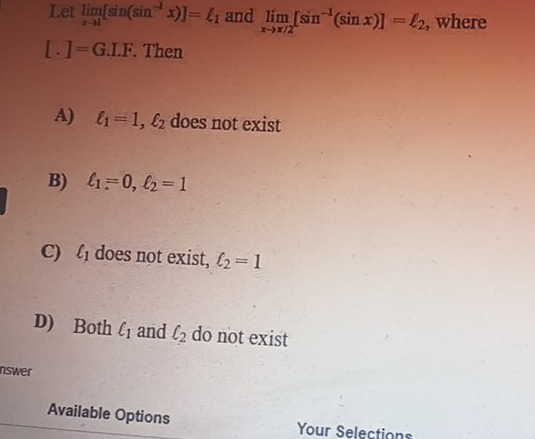Question
Question: Let $\lim_{x\to\pi}[\sin(\sin^{-1}x)]=\ell_1$ and $\lim_{x\to\pi/2}[\sin^{-1}(\sin x)]=\ell_2$, wher...
Let limx→π[sin(sin−1x)]=ℓ1 and limx→π/2[sin−1(sinx)]=ℓ2, where
[.]=G.I.F. Then

ℓ1=1, ℓ2 does not exist
ℓ1=0, ℓ2=1
ℓ1 does not exist, ℓ2=1
Both ℓ1 and ℓ2 do not exist
C
Solution
To evaluate the limits ℓ1 and ℓ2, we need to analyze the domain of the functions and the behavior of the greatest integer function (G.I.F.).
Evaluation of ℓ1=limx→π[sin(sin−1x)]
-
Domain of the function: The function is f(x)=sin(sin−1x). The domain of sin−1x is [−1,1]. Therefore, the domain of sin(sin−1x) is also [−1,1].
-
Limit point: The limit is taken as x→π. Since π≈3.14159, the value π is outside the domain [−1,1] of the function f(x).
-
Existence of limit: For a limit limx→ag(x) to exist, the function g(x) must be defined in a punctured neighborhood of a. In this case, as x→π, x is not in the domain of sin(sin−1x). Thus, the function is not defined in any neighborhood of π. Therefore, ℓ1 does not exist.
Evaluation of ℓ2=limx→π/2[sin−1(sinx)]
-
Understanding sin−1(sinx): The function g(x)=sin−1(sinx) is a periodic function with period 2π. Its graph is a triangular wave.
- For x∈[−π/2,π/2], sin−1(sinx)=x.
- For x∈[π/2,3π/2], sin−1(sinx)=π−x.
-
Evaluating the left-hand limit (LHL): As x→(π/2)−, x is slightly less than π/2. In this interval, sin−1(sinx)=x. So, limx→(π/2)−[sin−1(sinx)]=limx→(π/2)−[x]. Since π/2≈1.5708, as x approaches π/2 from the left, x is a value slightly less than 1.5708 (e.g., 1.5707). The greatest integer less than or equal to such a value is 1. Therefore, limx→(π/2)−[x]=1.
-
Evaluating the right-hand limit (RHL): As x→(π/2)+, x is slightly greater than π/2. In this interval, sin−1(sinx)=π−x. So, limx→(π/2)+[sin−1(sinx)]=limx→(π/2)+[π−x]. Let x=π/2+h, where h→0+. Then π−x=π−(π/2+h)=π/2−h. So, we need to evaluate limh→0+[π/2−h]. As h approaches 0 from the positive side, π/2−h is a value slightly less than π/2≈1.5708 (e.g., 1.5707). The greatest integer less than or equal to such a value is 1. Therefore, limx→(π/2)+[π−x]=1.
-
Conclusion for ℓ2: Since the LHL and RHL are equal (LHL=1, RHL=1), the limit ℓ2 exists and ℓ2=1.
Summary: ℓ1 does not exist. ℓ2=1.
This matches option C.
